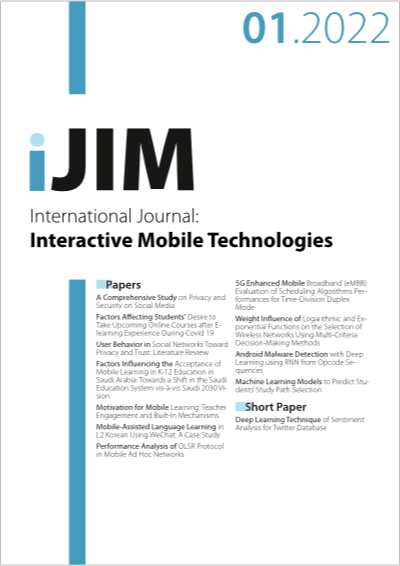Performance Analysis of OLSR Protocol in Mobile Ad Hoc Networks
DOI:
https://doi.org/10.3991/ijim.v16i01.26663Keywords:
olsr routing protocol, random mobility, group mobility, bonnmotion software, network simulation.Abstract
Optimized Link State Routing Protocol (OLSR) is an efficient routing protocol used for various Ad hoc networks. OLSR employs the Multipoint Relay (MPR) technique to reduce network overhead traffic. A mobility model's main goal is to realistically simulate the movement behaviors of actual users. However, the high mobility and mobility model is the major design issues for an efficient and effective routing protocol for real Mobile Ad hoc Networks (MANETs). Therefore, this paper aims to analyze the performance of the OLSR protocol concerning various random and group mobility models. Two simulation scenarios were conducted over four mobility models, specifically the Random Waypoint model (RWP), Random Direction model (RD), Nomadic Community model (NC), and the Reference Point Group Model (RPGM) with a low as well as high random range mobility of the nodes. Moreover, BonnMotion Software and Network simulator NS-3 used to implement the simulation scenarios. Further, the performance of the OLSR protocol analyzed and evaluated based on latency, routing overhead, and packet loss ratio metrics. According to the results, the OLSR protocol provides the best performance over the RWP model in a low mobility environment, whereas the Nomadic mobility model is suitable for OLSR protocol in a high mobility environment.
Downloads
Published
2022-01-18
How to Cite
Wheeb, A. H., & Al-jamali, N. A. (2022). Performance Analysis of OLSR Protocol in Mobile Ad Hoc Networks. International Journal of Interactive Mobile Technologies (iJIM), 16(01), pp. 106–119. https://doi.org/10.3991/ijim.v16i01.26663
Issue
Section
Papers
License
Copyright (c) 2021 Ali Hussein Wheeb, Nadia Adnan Al-jamali

This work is licensed under a Creative Commons Attribution 4.0 International License.



